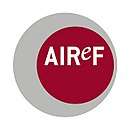Independent Authority for Fiscal Responsibility
The Independent Authority for Spanish Fiscal Responsibility (Autoridad Independiente de Responsabilidad Fiscal española, AIReF) is an independent agency for fiscal control in Spain. It was created in 2013 by the Spanish Government, on the initiative of the European Union and to implement a constitutional mandate. Its aim is to guarantee the principle of budgetary stability, as well as the country's financial sustainability.[1] Its office is in Madrid.

History
Independent fiscal control bodies began to be formed in other countries in the mid-20th century. The first was established in the Netherlands in 1947, followed by Denmark, Germany, US, Belgium, Austria, Korea, Sweden and Canada.[2]
The creation of such an authority in Spain formed part of the Spanish Strategy for Economic Policy, approved by the Spanish Council of Ministers in September 2012, with the intention of ensuring compliance with legal requirements on budgetary stability.[2] On 14 November 2013, the Government of Spain published Organic Law 6/2013, creating the Independent Authority of Spanish Fiscal Responsibility (AIReF). The appointment of the first president was approved in February, having been accepted by the Congressional Commission of Inland Revenue and Public Administration. In March 2014 the Organic Law was approved and in the second quarter the rest of the Managerial Committee was created, comprising the president and the directors of the three divisions that make up the AIReF, with the assistance of the Director of the Spanish President's Cabinet. The Managerial Committee first met in June 2014, a date that may be considered as the start of the institution's activities. All the records of the Committee are published.[3] The Action Plan for 2014 was approved in July that year, and early in 2015 the Strategic Plan 2015–2020 was also approved.[4]
On 18 April 2016 AIReF issued a communiqué expressing concern over the absence of data needed to prepare its annual report on macroeconomic forecasts.[5]
Presidency
José Luis Escrivá was appointed president of AIReF in February 2014. In January 2020, Escrivá left AIRef to take up a ministerial position at the Ministry of Inclusion, Social Security and Migration as part of the Sánchez II Government.[6]
Objectives
Some of AIReF's main aims are:[7]
- Transparency: to facilitate the publication and dissemination of data, and note possible bias in fiscal and macroeconomic projections issued by the Spanish authorities.
- Discipline: to provide an independent source of discipline, not exposed to the pressure of interest groups; commitment to medium-term financial objectives, ignoring any pressures on political parties stemming from the electoral cycle.
- Coordination: to advocate the internalization of any issues arising from fiscal indiscipline.
Structure
The structure and activities of AIReF are regulated under the Organic Statute of the Independent Authority of Fiscal Responsibility, collected in the Royal Decree 215/2014, of 28 March 2014. This regulates among other things data analysis, publication, the functions of the president, and the control of the institution's own expenditure. AIReF comprises the president's office and three divisions—Budgetary Analysis, Economic Analysis and Legal Affairs.[8]
Advisory board
Under the founding statute, the president may be advised by professionals in relevant fields, for which purpose an Advisory Board has been formed.[9] The president may attend the Managerial Committees.
IFI network
AIReF is part of a network of Independent Fiscal Institutions (IFI's) in other European countries. This network has set up a Committee for European Affairs, with the aim of constructing a Europe-wide platform to help the IFI's carry out their functions effectively, in particular those arising from the fiscal framework of the European Union.[10]
References
- El Congreso da luz verde definitiva a la Autoridad Fiscal Independiente ("Congress gives definitive green light to the Independent Fiscal Authority"), CincoDias, 13 November 2013.
- La presión de la UE acelera la oficina fiscal independiente ("Pressure from the EU hastens the independent fiscal office"), CincoDias, 8 March 2013.
- Escrivá, nuevo presidente de la autoridad fiscal independiente ("Escrivá, the new president of the independent fiscal authority"), CincoDias, 24 January 2014.
- Strategic Plan 2015–2020, accessed 9 October 2017.
- Communiqué by AIReF Archived 15 February 2017 at the Wayback Machine, AIReF official website, 18 April 2016, accessed 19 April 2016.
- "José Luis Escrivá, nuevo ministro de Seguridad Social, Inclusión y Migraciones". El Mundo (in Spanish). 10 January 2020. Retrieved 12 January 2020.
- La autoridad fiscal independiente ("The independent fiscal authority"), CincoDías, 11 November 2013.
- The Team, AIReF website, accessed 9 October 2017.
- Consejo Asesor de AIReF (membership of the Advisory Board), AIReF website, accessed 9 October 2017.
- IFI network, official website, accessed 19 April 2016.